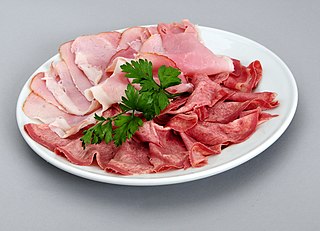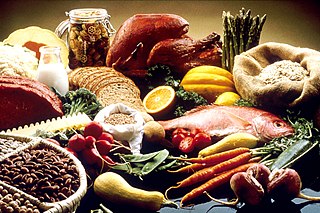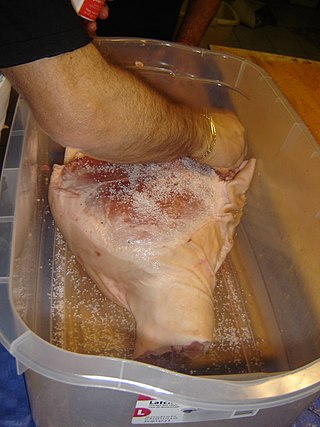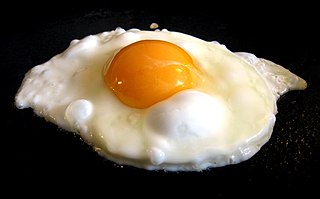
Dairy products or milk products, also known as lacticinia, are food products made from milk. The most common dairy animals are cow, water buffalo, nanny goat, and ewe. Dairy products include common grocery store food around the world such as yogurt, cheese, milk and butter. A facility that produces dairy products is a dairy. Dairy products are consumed worldwide to varying degrees. Some people avoid some or all dairy products because of lactose intolerance, veganism, environmental concerns, other health reasons or beliefs.

Meat is animal tissue, often muscle, that is eaten as food. Humans have hunted and farmed other animals for meat since prehistory. The Neolithic Revolution allowed the domestication of animals, including chickens, sheep, goats, pigs, horses, and cattle, starting around 11,000 years ago. Since then, selective breeding has enabled farmers to produce meat with the qualities desired by producers and consumers.

The Mediterranean diet is a concept first invented in 1975 by the American biologist Ancel Keys and chemist Margaret Keys. The diet took inspiration from the supposed eating habits and traditional food typical of Crete, much of the rest of Greece, and southern Italy, and formulated in the early 1960s. It is distinct from Mediterranean cuisine, which covers the actual cuisines of the Mediterranean countries, and from the Atlantic diet of northwestern Spain and Portugal. While inspired by a specific time and place, the "Mediterranean diet" was later refined based on the results of multiple scientific studies.

Lunch meats—also known as cold cuts, luncheon meats, cooked meats, sliced meats, cold meats, sandwich meats, delicatessens, and deli meats—are precooked or cured meats that are sliced and served cold or hot. They are typically served in sandwiches or on a tray. They can be purchased pre-sliced, usually in vacuum packs, or they can be sliced to order, most often in delicatessens.

A plant-based diet is a diet consisting mostly or entirely of plant-based foods. Plant-based diets encompass a wide range of dietary patterns that contain low amounts of animal products and high amounts of fiber-rich plant products such as vegetables, fruits, whole grains, legumes, nuts and seeds. They do not need to be vegan or vegetarian, but are defined in terms of low frequency of animal food consumption.

A healthy diet is a diet that maintains or improves overall health. A healthy diet provides the body with essential nutrition: fluid, macronutrients such as protein, micronutrients such as vitamins, and adequate fibre and food energy.

Processed meat is considered to be any meat that has been modified in order to either improve its taste or to extend its shelf life. Methods of meat processing include salting, curing, fermentation, smoking, boiling, frying, and/or the addition of chemical preservatives. Processed meat is usually composed of pork or beef or, less frequently, poultry. It can also contain offal or meat by-products such as blood. Processed meat products include bacon, ham, sausages, salami, corned beef, jerky, hot dogs, lunch meat, canned meat, chicken nuggets, and meat-based sauces. Meat processing includes all the processes that change fresh meat with the exception of simple mechanical processes such as cutting, grinding or mixing.

In culinary terms, white meat is meat which is pale in color before and after cooking. In traditional gastronomy, white meat also includes rabbit, the flesh of milk-fed young mammals, and sometimes pork. In ecotrophology and nutritional studies, white meat includes poultry and fish, but excludes all mammal flesh, which is considered red meat.

Alcohol and cancer have a complex relationship. Alcohol causes cancers of the oesophagus, liver, breast, colon, oral cavity, rectum, pharynx, and larynx, and probably causes cancers of the pancreas. Cancer risk can occur even with light to moderate drinking. The more alcohol is consumed, the higher the cancer risk, and no amount can be considered completely safe.
The health effects of coffee include various possible health benefits and health risks.

Curing is any of various food preservation and flavoring processes of foods such as meat, fish and vegetables, by the addition of salt, with the aim of drawing moisture out of the food by the process of osmosis. Because curing increases the solute concentration in the food and hence decreases its water potential, the food becomes inhospitable for the microbe growth that causes food spoilage. Curing can be traced back to antiquity, and was the primary method of preserving meat and fish until the late 19th century. Dehydration was the earliest form of food curing. Many curing processes also involve smoking, spicing, cooking, or the addition of combinations of sugar, nitrate, and nitrite.

Many dietary recommendations have been proposed to reduce the risk of cancer, few have significant supporting scientific evidence. Obesity and drinking alcohol have been correlated with the incidence and progression of some cancers. Lowering the consumption of sweetened beverages is recommended as a measure to address obesity.

The Western pattern diet is a modern dietary pattern that is generally characterized by high intakes of pre-packaged foods, refined grains, red meat, processed meat, high-sugar drinks, candy and sweets, fried foods, industrially produced animal products, butter and other high-fat dairy products, eggs, potatoes, corn, and low intakes of fruits, vegetables, whole grains, pasture-raised animal products, fish, nuts, and seeds.

Animal source foods (ASF) include many food items that come from an animal source such as fish, meat, dairy, eggs and honey. Many individuals consume little ASF or even none for long periods of time by either personal choice or necessity, as ASF may not be accessible or available to these people.

Humans and their hominid relatives have consumed eggs for millions of years. The most widely consumed eggs are those of fowl, especially chickens. People in Southeast Asia began harvesting chicken eggs for food by 1500 BCE. Eggs of other birds, such as ducks and ostriches, are eaten regularly but much less commonly than those of chickens. People may also eat the eggs of reptiles, amphibians, and fish. Fish eggs consumed as food are known as roe or caviar.

Diet plays an important role in the genesis of obesity. Personal choices, food advertising, social customs and cultural influences, as well as food availability and pricing all play a role in determining what and how much an individual eats.

Heterocyclic amines are a group of chemical compounds, many of which can be formed during cooking. They are found in meats that are cooked to the "well done" stage, in pan drippings and in meat surfaces that show a brown or black crust. Epidemiological studies show associations between intakes of heterocyclic amines and cancers of the colon, rectum, breast, prostate, pancreas, lung, stomach, and esophagus, and animal feeding experiments support a causal relationship. The U.S. Department of Health and Human Services Public Health Service labeled several heterocyclic amines as likely carcinogens in its 13th Report on Carcinogens. Changes in cooking techniques reduce the level of heterocyclic amines.

Frank B. Hu is a Chinese American nutrition and diabetes researcher. He is Chair of the Department of Nutrition and the Fredrick J. Stare Professor of Nutrition and Epidemiology at the Harvard T.H. Chan School of Public Health, and Professor of Medicine at the Harvard Medical School.

Cancer prevention is the practice of taking active measures to decrease the incidence of cancer and mortality. The practice of prevention depends on both individual efforts to improve lifestyle and seek preventive screening, and socioeconomic or public policy related to cancer prevention. Globalized cancer prevention is regarded as a critical objective due to its applicability to large populations, reducing long term effects of cancer by promoting proactive health practices and behaviors, and its perceived cost-effectiveness and viability for all socioeconomic classes.

Ultra-processed foods (UPFs) are industrially manufactured foods that are designed to be convenient, palatable, and affordable. These foods often contain multiple ingredients and additives such as preservatives, sweeteners, colorings, and emulsifiers, which are not typically found in home kitchens. They tend to be low in fiber and high in calories, salt, added sugar and fat, which are all related to poor health outcomes when eaten excessively. Common examples include packaged snacks, soft drinks, ready meals, and processed meats.
























